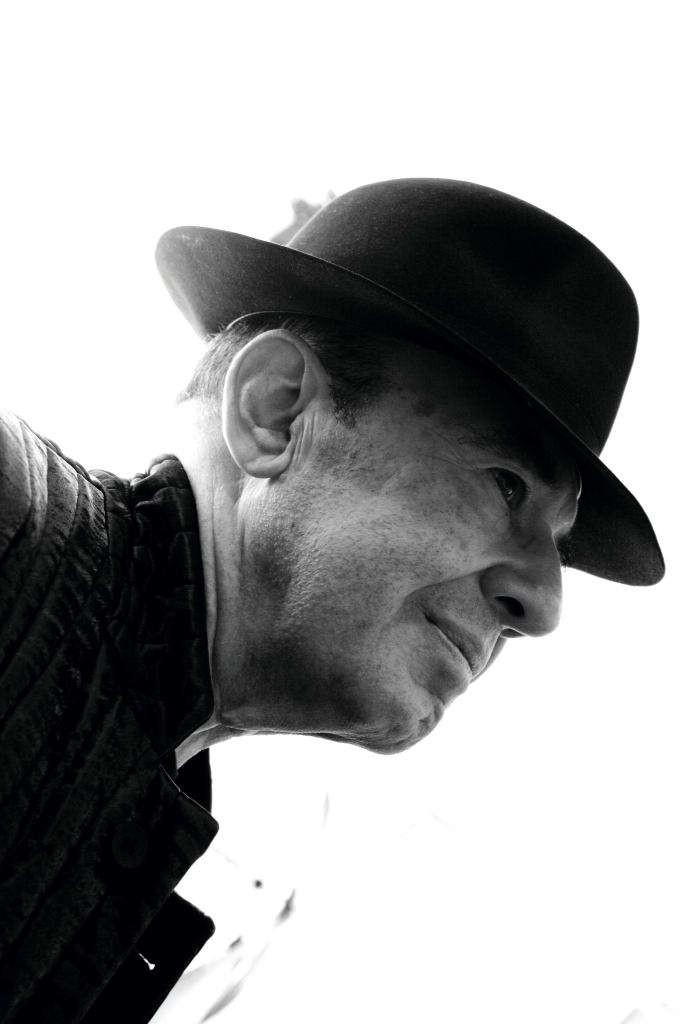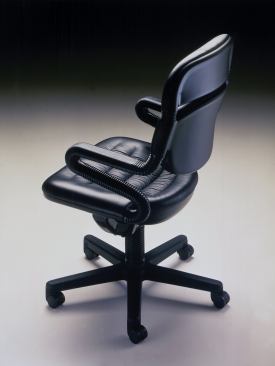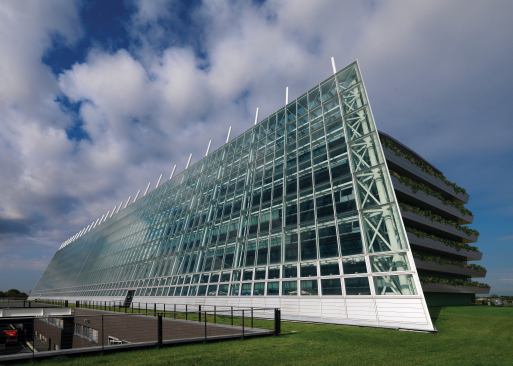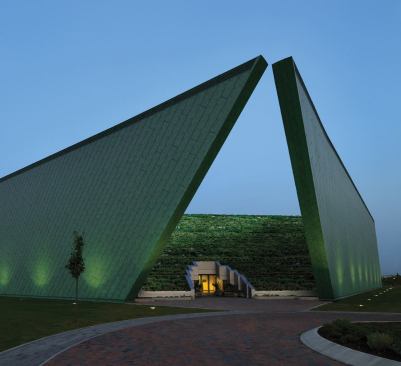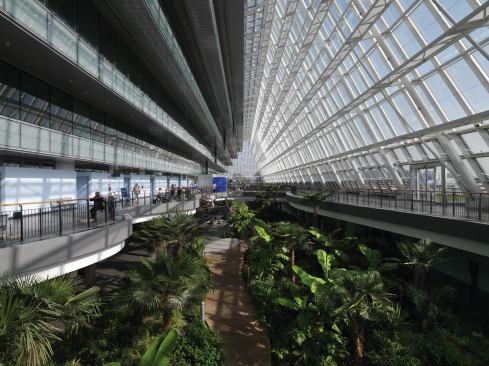Courtesy of Emilio Ambasz hon. faia
1976: The Taxi Project exhibition at MoMA, organized by Ambasz a…
In the midst of a two-hour conversation in his book-lined study, Emilio Ambasz slowly lobs a remark that lands with the bluntness of a lead pipe. “I am, honestly, an image maker,” he confesses. The statement—a gross oversimplification—lies somewhere in the murky realm between fact and fiction. The same can be said of the enigmatic persona Ambasz has created for himself.
After decades being celebrated as a student, curator, educator, architect, and industrial designer, has Ambasz crafted memorable images through his visions for buildings and mass-produced products? Absolutely. Can the totality of his wide-ranging career be summed up in such a distilled phrase? Hardly.
For testament to that fact, simply look at the validation accorded to Ambasz by the Museum of Modern Art (MoMA) in New York, 40 years after Ambasz was hired as a curator there. At a panel discussion held in April at the museum, scholars and veteran designers assembled to discuss the significance of the acclaimed 1972 exhibition “Italy: The New Domestic Landscape,” organized by Ambasz. A companion show this spring at Columbia University brought together for the first time since 1972 the entire set of films produced for the portion of the exhibition that focused on a series of designed “Environments.” And in October, MoMA will stage another conference to revisit Ambasz’s “Universitas” project, an unrealized effort to create an experimental university.
“?‘Universitas’ was the most ambitious [of Ambasz’s curatorial projects], involving the projection of a type of university in which issues of environment and design would be central disciplinary structures,” says Barry Bergdoll, MoMA’s current chief curator of architecture and design. In coming back to it, Bergdoll says, “it is our aim … to launch a new debate at precisely a time when worldwide universities are either in a state of crisis or actively exploring what a university needs to be in the next generation and in the rest of the century.”
Since Ambasz left the museum in 1976 to pursue an independent career as a designer, he has twice been the subject of MoMA exhibitions—the first one in 1989 highlighting his architectural projects and the second, in 2005, featuring a single residence, La Casa de Retiro Espiritual in Spain.
Yet in spite of the attention lavished on him by those with a theoretical bent, as well as countless national and international honors (including three P/A Awards) and the publication of his work in international journals and in monographs, he has somehow eluded popular acclaim—and so is little known by contemporary students, is underappreciated by his colleagues in the architectural profession, and is lost in the media blur that scatters random perceptions of architecture and design among a largely unaware public. “Emilio who?”
A quick studyAmbasz in person—an engaging combination of good manners, easy self-confidence, and an impish sense of humor—forms an immediate impression on the visitor to his office in a commodious Upper West Side apartment in New York. Set in contrast to the traditional domestic space are characteristic signs of a resolute modernist, from the glass-topped conference table to the sleek coffee service. Ambasz appears through the door wearing a brown pinstriped jacket over a black T-shirt. A burgundy-and-navy handkerchief peers out from the breast pocket as he extends a welcoming hand.
Born in Chaco, a subtropical province of Argentina, Ambasz says he knew he wanted to be an architect from the time he was 11. “When I was 13 years old, 14 at the most, I designed a house for a couple who were teachers of mine on a little plot of land. It was a cubist building with two cuts in the façade.” By the time he was 16, Ambasz found a job in the Buenos Aires office of architect Amancio Williams, whose work he still admires. He attended high school classes at night in order to work for Williams during the day.
As the minutes drift by, Ambasz weaves stories colorful enough to invite skepticism. He claims not only to have audited architecture classes in the university as a teenager, but to have taught himself English—“a forbidden imperialist language during the rule of Juan Perón”—by reading books and watching American movies on TV. Ambasz says he watched so many American westerns that when he moved to the United States, he was ridiculed by a girlfriend for sounding like Gary Cooper.
What we know for certain is this: Ambasz entered Princeton with a rare intelligence and a passion for architecture. After two years there, he was awarded both a Bachelor’s and a Master’s degree. “Emilio was briefly a student of mine, if I can say that,” says Kenneth Frampton, now Ware Professor of Architecture at Columbia. “But I hardly can. I mean, he was already a very precocious person and very self-competent, and there wasn’t very much I could contribute.”
Virtually overnight, Ambasz advanced from student to teacher at Princeton. But it wasn’t long before he caught the eye of Arthur Drexler, director of the Department of Architecture and Design at MoMA. At age 25, Ambasz joined the museum’s staff as a curator. “Like Thomas à Becket, I thought MoMA was a higher calling, mainly because there were no compromises there,” he says now.
MoMA years and “inventions”
From 1969 to 1976, Ambasz directed and installed numerous influential exhibitions on architecture and industrial design at MoMA, including “Italy: The New Domestic Landscape” and “The Architecture of Luis Barragán.” The first of these challenged established notions of industrial design and introduced new social and political dimensions to the discussion; the second was important for its pioneering effort to bring Barragán’s work into focus.
While these two exhibits—and another called “The Taxi Project”—were critical successes, Ambasz’s most visionary effort at MoMA was the project to develop a new university suited to a post-technological society, his so-called “Universitas.”
It was an unusual program for MoMA to undertake, an ambitious research project questioning the adequacy of prevailing institutions to deal with the increasingly complex problems of the manmade environment. More than a dozen of the world’s top thinkers, including sociologist Henri Lefebvre and political theorist Hannah Arendt, assembled in New York for a symposium in January 1972. But the hopes for quick action and public funding went unfulfilled, and MoMA did not publish the proceedings (all 500 pages of them) until 2006.
Ambasz still holds tight to the vision. “We now need a university concerned not only with measuring nature as found, but dealing with the fact that in the process of mastering nature, we are creating a new manmade nature,” he says today. “Design is an act of the lonely jump. It is not something you can do deductively. It is an inductive production, and you need different systems of thought.”
Eventually his curatorial explorations led Ambasz to delve deeper into industrial design. After seven years at MoMA, he left to pursue this new direction. Soon he brought to market his Vertebra, an automatically adjustable office chair he designed in collaboration with Giancarlo Piretti. The first of its kind, the Vertebra gave rise to an entire industry in ergonomic seating. A testament to its significance: the chair resides in the collections of both MoMA and the Metropolitan Museum of Art.
A sequence of successful products followed, including a toothbrush, a watch, an electric shaver, a telephone, and a pocket-sized, folding TV. A favorite was the Flexibol pen made by Pentel. Designed for schoolchildren, the brightly colored ballpoint pens were made to flex, not break, when placed in a child’s pocket. But when the pen body was twisted to expose the tip for writing, its housing adjusted to create a rigid writing instrument.
The conception and detailing of these objects revealed what critic Michael Sorkin referred to as Ambasz’s “graceful tinkerer’s sense of mechanism”—pre-electronic and decidedly non-virtual. “I have a flair for solving problems,” agrees Ambasz. “Many years ago, Alessandro Mendini, who at the time was the editor of Domus, asked me how I would define myself professionally. And I said I would define myself as an inventor. To me, architecture is an act of the imagination. Industrial design is an act of the imagination.”
Built works
By the late 1980s, Ambasz was turning heads with his proposals for buildings, many of which were rendered like fantasy environments striving for a harmonious integration of building and nature. A previously little-known botanical society in San Antonio took a gamble when it commissioned Ambasz to design the Lucile Halsell Conservatory. The risk paid off: His vision of a sunken courtyard surrounded by abstract glass structures celebrating the passage from earth to sky and darkness to light was an immediate sensation. In 1989, the year after the conservatory opened, Ambasz was featured with Steven Holl in a two-part exhibition at MoMA.
There’s no doubt that the Halsell Conservatory, along with other designs such as the 1994 ACROS Fukuoka Prefectural International Hall and the 1994 Mycal Cultural and Athletic Center (both in Japan), began to reinforce his reputation for independence from the in-crowd. Why, at the height of Postmodernism, when celebrated architecture was primarily about formalism and little about tectonics, did he play a different tune?
“Maybe because I was a modernist,” he offers. “I felt that the postmodernists were answering a need, but they were giving the wrong answer. They were acknowledging a real need for ornament. I wanted ornament too, but not in that way. My way of doing ornament is by using nature.”
Ambasz is sometimes credited as a forerunner of today’s sustainability movement. After all, he was pioneering green architecture before it was fashionable. But while he is sensitive to the user benefits of earth-sheltered housing, for example, the emphasis for him is not on building performance, but aesthetics. He freely admits that when he attends sustainability conferences, he feels like an interloper among the techno-savvy. “I use the science to check what I have conceived,” he says. “But I don’t conceive buildings in those terms. My notion is I have to create images that move the heart. If you don’t move the heart, what is the point of building?”
Today Ambasz divides his time among many places—three months a year in New York and much of the rest of the year in Italy, where he maintains homes in Bologna, Venice, Milan, and Florence. Working from so many locales, he continues to build in far-flung places. In Venice, he recently completed a 680-bed hospital that includes a large “winter garden” and an adjacent ophthalmological center with a stepped green roof. His Museum of Modern Art and Cinema in Buenos Aires is scheduled for completion in 2010. Other works-in-progress include an apartment building in Switzerland, a hotel and residential development in Malaysia, and a large hotel in upstate New York. For such a small boutique firm, the output is astounding.
What helps is that, in most cases, Ambasz’s clients are other architects. Ambasz—who has an Argentinian architectural license and the designation of Hon. FAIA—is called in to do the preliminary design and design development drawings, or sometimes as little as a sketch, and the local registered architect does the working drawings and supervises construction. “I do not have legal power,” Ambasz explains. “But I have moral power to control the project.”
Ambasz’s incredible intellect and breadth of production put him in rare company. So how has he avoided celebrity status? Why, in spite of the accolades, does one sense that he is content to operate on the fringes of professional culture?
The answers are as elusive as the man himself. One comes from Alessandro Mendini, who suggests in a passage on Ambasz’s own website that his “very large and complex body of work doesn’t seem to seek the friendship of the academy, nor care to contribute to the canonical history of architecture, design, and language.”
Another possibility emerges in conversation with Kenneth Frampton, who hastens to describe Ambasz as warm, witty, and just, but acknowledges his lingering inscrutability. “The stories he tells you about his life are sometimes preposterous, in a way, given what you know of his life history. But I’ve never had any reason to disbelieve anything he ever said to me. In that sense, he remains a bit of a mystery. And he likes to remain a mystery.”
